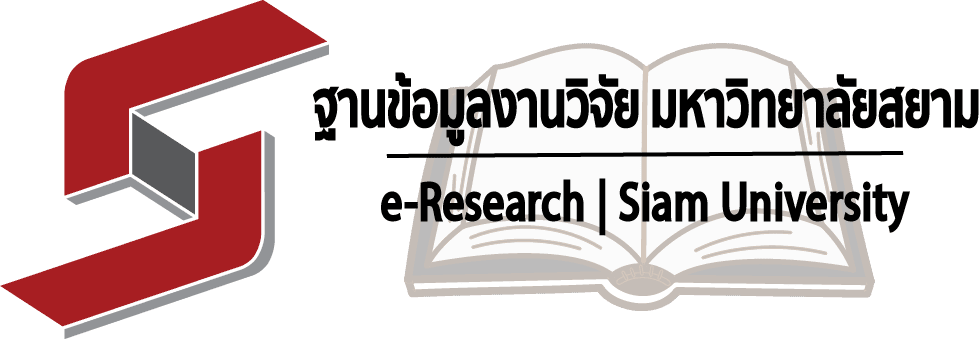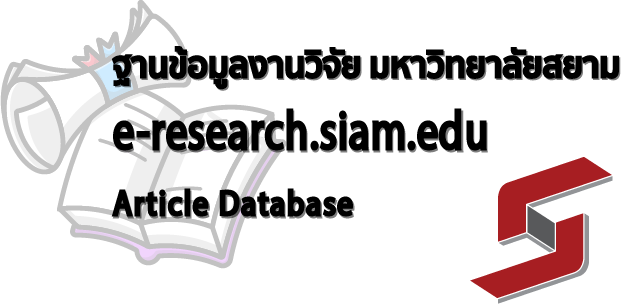- KB Home
- หลักสูตรระดับบัณฑิตศึกษา|Graduate Schools
- หลักสูตรปริญญาเอก|Doctoral Degree
- D.B.A.
- กลยุทธ์การตลาดเพื่อพัฒนาภาพลักษณ์ของวิทยาลัยอาชีวศึกษาเอกชนในประเทศไทย
| หัวข้อวิทยานิพนธ์: Project Title: |
กลยุทธ์การตลาดเพื่อพัฒนาภาพลักษณ์ของวิทยาลัยอาชีวศึกษาเอกชนในประเทศไทย Marketing Strategies for Developing of Private Vocational Colleges’ Image in Thailand |
| ชื่อนักศึกษา: Author: |
นางภาวิณีย์ มาตแม้น Mrs. Phavinee Matman |
| อาจารย์ที่ปรึกษา: Advisor: |
รศ.จินตนา บุญบงการ Assoc. Prof. Chintana Bunbongkran |
| ระดับการศึกษา: Degree: |
บริหารธุรกิจดุษฎีบัณฑิต (บธ.ด.) Doctor of Business Administration |
| สาขาวิชา: Major: |
การตลาด Marketing |
| คณะ: Faculty: |
บัณฑิตวิทยาลัย Graduate Schools |
| ปีการศึกษา: Academic year: |
2557 2016 |
การอ้างอิง|Citation
ภาวิณีย์ มาตแม้น. (2557). กลยุทธ์การตลาดเพื่อพัฒนาภาพลักษณ์ของวิทยาลัยอาชีวศึกษาเอกชนในประเทศไทย. (วิทยานิพนธ์ปรัชญาดุษฎีบัณฑิต). กรุงเทพฯ: บัณฑิตวิทยาลัย มหาวิทยาลัยสยาม.
Matman P. (2016). Marketing strategies for developing of private vocational colleges’ image in Thailand. (Doctoral dissertation). Bangkok: Graduate Schools Siam University.
บทคัดย่อ
การศึกษากลยุทธ์การตลาดเพื่อพัฒนาภาพลักษณ์ของวิทยาลัยอาชีวศึกษาเอกชนในประเทศไทย มี วัตถุประสงค์เพื่อ (1) เพื่อศึกษาการบริหารจัดการของวิทยาลัยอาชีวศึกษาเอกชนในปัจจุบัน (2) เพื่อ ศึกษากลยุทธ์การตลาดเพื่อพัฒนาภาพลักษณ์ของวิทยาลัยอาชีวศึกษาเอกชนในประเทศไทย (3) เพื่อ วิเคราะห์หาความสัมพันธ์เชิงสาเหตุที่เกี่ยวข้องระหว่างการบริหารจัดการของวิทยาลัยอาชีวศึกษา เอกชนกับกลยุทธ์การตลาดที่ส่งผลต่อภาพลักษณ์วิทยาลัยอาชีวศึกษาเอกชน และนําไปสู่ความภักดี ต่อวิทยาลัยอาชีวศึกษาเอกชนในประเทศไทย (4) เพื่อกําหนดกลยุทธ์การตลาดในการพัฒนา ภาพลักษณ์ของวิทยาลัยอาชีวศึกษาเอกชนของไทยที่มีประสิทธิภาพ และเหมาะสมสําหรับวิทยาลัย อาชีวศึกษาในประเทศไทย
การวิจัยครั้งนี้เป็นการวิจัยแบบผสมผสานโดยแบ่งออกเป็น 2 ส่วน คือ ส่วนที่ 1 การวิจัยเชิง คุณภาพ เพื่อศึกษาการบริหารจัดการของวิทยาลัยอาชีวศึกษาเอกชนในปัจจุบันโดยการเก็บข้อมูลกลุ่ม ตัวอย่างจากผู้แทนในหน่วยงานที่มีส่วนเกี่ยวข้องกับการศึกษาวิทยาลัยอาชีวศึกษาเอกชน ทั้ง หน่วยงานภาครัฐและภาคเอกชน จํานวน 20 คน ใช้วิธีการศึกษาจากเอกสาร และการสัมภาษณ์เชิงลึก จากบุคคลที่เกี่ยวข้องในแวดวงการอาชีวศึกษาของไทย วิเคราะห์ข้อมูลดังกล่าวตามแนวทางการ วิเคราะห์ข้อมูลเชิงคุณภาพส่วนที่ 2 การวิจัยเชิงปริมาณเป็นศึกษากลยุทธ์การตลาดเพื่อพัฒนา ภาพลักษณ์ของวิทยาลัยอาชีวศึกษาเอกชน โดยเก็บข้อมูลจากกลุ่มตัวอย่างนักเรียนระดับ ประกาศนียบัตรวิชาชีพ (ปวช. 1-3) ประเภทพณิชยกรรม และช่างอุตสาหกรรม ในกลุ่ม กรุงเทพมหานคร กลุ่มภาคตะวันออกเฉียงเหนือ กลุ่มภาคเหนือ กลุ่มภาคกลาง และกลุ่มภาคใต้ จํานวน 1,200 คนใช้แบบสอบถามเป็นเครื่องมือในการเก็บรวบรวมข้อมูลวิเคราะห์ข้อมูลโดยใช้สถิติ เชิงพรรณาสถิติเชิงอนุมาน และการวิเคราะห์โมเดลสมการ โครงสร้าง โดยใช้โปรมแกรม SPSS และ โปรแกรม AMOSเพื่อวิเคราะห์หาความสัมพันธ์เชิงสาเหตุที่เกี่ยวข้องระหว่างการบริหารจัดการของ วิทยาลัยอาชีวศึกษาเอกชนกับกลยุทธ์การตลาดที่ส่งผลต่อภาพลักษณ์ของวิทยาลัยอาชีวศึกษาเอกชน และนําไปสู่ความภักดีต่อวิทยาลัยอาชีวศึกษาเอกชนในประเทศไทยที่มีความกลมกลืนของโมเดลเชิง สาเหตุและสอดคล้องกับผลในการวิจัยข้อมูลเชิงประจักษ์ ผลการศึกษาตามวัตถุประสงค์ข้อที่ 1 พบว่าการบริหารจัดการของวิทยาลัยอาชีวศึกษาเอกชนมี ความสัมพันธ์กับกลยุทธ์การตลาดและมีความสัมพันธ์ทางตรงกับภาพลักษณ์ของวิทยาลัยอาชีวศึกษา เอกชน รวมทั้งภาพลักษณ์วิทยาลัยอาชีวศึกษาเอกชนมีความสัมพันธ์ทางตรงกับความภักดีของ นักเรียนในวิทยาลัยอาชีวศึกษาเอกชนในประเทศไทย สําหรับผลการศึกษาตามวัตถุประสงค์ข้อที่ 2 พบว่ากลุ่มตัวอย่างของนักเรียนมีความเห็นด้วยอยู่ในระดับมากที่สุดเกี่ยวกับค่าธรรมเนียมทาง การศึกษา วิทยาลัยและการให้บริการ บุคคลที่ให้บริการ และเห็นด้วยอยู่ในระดับมากเกี่ยวกับ สถาน ที่ตั้งวิทยาลัย กระบวนการ ให้บริการ และการประชาสัมพันธ์ สําหรับผลการศึกษาตามวัตถุประสงค์ ข้อที่ 3 พบว่า กลยุทธ์การตลาดมีความสัมพันธ์ทางบวกกับการพัฒนาภาพลักษณ์ของวิทยาลัย อาชีวศึกษาเอกชนโดยตรงและส่งไปยังความภักดีของนักเรียนที่มีต่อวิทยาลัยอาชีวศึกษาเอกชนใน ประเทศไทย สําหรับผลการศึกษาตามวัตถุประสงค์ข้อที่ 4 พบว่ากลยุทธ์การตลาดเพื่อพัฒนา ภาพลักษณ์ของวิทยาลัยอาชีวศึกษาเอกชนในประเทศไทยได้สร้างความภักดีให้กับนักเรียน จึงได้ โมเดลความสัมพันธ์เชิงสาเหตุที่พัฒนาขึ้น ซึ่งมีความเหมาะสม เนื่องจากมีความสอดคล้องกับข้อมูล เชิงประจักษ์ อีกทั้งในแต่ละองค์ประกอบของโมเดลมีความเที่ยงตรง และมีความสามารถในการ พยากรณ์ได้ในระดับดี และเป็นที่ยอมรับได้ สําหรับค่าธรรมเนียมทางการศึกษาเป็นตัวแปรสําคัญมาก ที่สุดของกลยุทธ์การตลาด ส่วนความสําเร็จของวิทยาลัยอาชีวศึกษาเอกชนเป็นตัวแปรสําคัญมากที่สุด ของภาพลักษณ์ และการศึกษาต่อ ณ สถานศึกษาเดิมเป็นตัวแปรสําคัญมากที่สุดของความภักดีต่อ วิทยาลัยอาชีวศึกษาเอกชนในประเทศไทย
ผู้วิจัยจึงได้วิเคราะห์และสังเคราะห์จากผลการวิจัย ทั้งการวิจัยเชิงคุณภาพและผลการวิจัยเชิง ปริมาณ ได้แนวทางการนําผลการวิจัยไปประยุกต์ใช้ในการพัฒนาภาพลักษณ์ของวิทยาลัยอาชีวศึกษา เอกชนในประเทศไทย เพื่อสร้างความภักดีให้กับนักเรียนระดับประกาศนียบัตรวิชาชีพ (ปวช.1-3) สามารถดําเนินการได้โดยการนํากลยุทธ์การตลาด 7 Ps ได้แก่ (1) กลยุทธ์วิทยาลัยและการให้บริการ (2) กลยุทธ์ค่าธรมเนียมทางการศึกษา (3) กลยุทธ์สถานที่ตั้งวิทยาลัย (4) กลยุทธ์การประชาสัมพันธ์ (5)กลยุทธ์บุคคลที่ให้บริการ (6) กลยุทธ์กระบวนการให้บริการ (7) กลยุทธ์หลักฐานทางกายภาพ จึงนําไปสู่การพัฒนาภาพลักษณ์ของวิทยาลัยอาชีวศึกษาเอกชนของประเทศไทยที่มีประสิทธิภาพและ เหมาะสม ที่เรียกว่า M-IMAGE ประกอบด้วย (1) Identity การสร้างอัตลักษณ์ที่ชัดเจนและโดดเด่น (2) Media การใช้สื่อเพื่อประชาสัมพันธ์ (3) Alliance การทําความร่วมมือกับหน่วยงานทั้งภาครัฐและ ภาคเอกชน (4) Global การพัฒนาหลักสูตรนานาชาติ (5) Electronics Commerce การจัดการศึกษาเชิง พณิชย์ซึ่งสามารถนํามาประยุกต์ใช้ในแต่ละภูมิภาคที่ตั้งของวิทยาลัยอาชีวศึกษาเอกชนในประเทศ ไทยได้อย่างเหมาะสมและมีประสิทธิภาพ
Abstract
The marketing strategies for developing of private vocational colleges’ image in Thailand aimed to 1) study the current management of private vocational colleges in Thailand 2) study the marketing strategies for developing of private vocational colleges’ image in Thailand 3) analyze relevant causal relationship between the management, marketing strategies, and image perception of private vocational colleges that affects the loyalty of students in private vocational colleges in Thailand 4) determine the marketing strategies for developing of efficient private vocational colleges’ image in Thailand, and suitable for private vocational colleges in Thailand.
This study was mixed methodology, and divided into two parts as following:
The first part was qualitative research.
According to study the current management of private vocational colleges in Thailand, this study employed to use documents and in-depth interviews for data gathering the 20 representatives of private vocational education institutions which included government and private vocational education. Data analysis was analyzed by qualitative methodology.
The second part was quantitative research.
According to study marketing strategies for developing of private vocational colleges’ image in Thailand, the data were collected from, first-year, second-year, and third-year, vocational certificate students (n=1,200) in the vocational colleges in commercial program and industrial program who studied in five different regions of Thailand: North, Northeast, East, Central, and South during academic year 2012. This part also provided questionnaires for data collection. The data were collected by descriptive statistics, inferential statistics, and analysis structural equation model; furthermore, To ensure that the results would be generalizable, the data from the returned questionnaire were statistically analyzed by using the SPSS and AMOS programs to analyze relevant causal relationship between the management, marketing strategies, and image perception of private vocational colleges that affects the loyalty of students in private vocational colleges in Thailand that the model is in harmony with the observational data empirical.
The research finding followed the first objective found that the vocational management factors had strong relationship with marketing strategies and image of private vocational education; in addition, the image factors correlated with the loyalty of private vocational education.
The research finding followed the second objective found that students highlighted the results that the main marketing strategies for developing of private vocational colleges’ image in Thailand consisted of the highest strategy was tuition and services; on the other hand, the high strategy was services process and public relation were high.
The research finding followed the third objective found that the marketing strategies had significant positive relationship with image of private vocational education; the image factors also correlated with the loyalty of private vocational education.
The research finding followed the fourth objective found that the marketing strategies of vocational education would be beneficial for developing the vocational colleges’ image in Thailand and creating loyalty of vocational students. The causal relationship model developed by authors is well fitted to empirical data; therefore, the elements of the model were validity, predictability, and acceptable. According to the results of the study, the tuition was significant variable of marketing strategies, college achievement was significant variable of vocational colleges’ image and continuing education at previous college was significant variable of loyalty of private vocational colleges in Thailand.
The researcher analyzed and synthesized the findings from qualitative and quantitative methods would be guideline for application for developing of private vocational colleges’ image in Thailand for producing the loyalty of, first-year, second-year, and third-year, vocational certificate students consists of 7 strategies (7 P’s): 1) colleges and services strategy 2) tuition strategy 3) location strategy 4) public relation strategy 5) service provider strategy 6) services process strategy, and 7) services evidence strategy. These strategies conduced to, M-IMAGE, the development of efficient and suitable private vocational colleges’ image in Thailand. M-IMAGE composed of 1) Identity- creating an apparent identity 2) Media- using the media to public relations 3) Alliance- the cooperation with government and private sectors 4) Global- the development of international curriculum, and 5) Electronics Commerce- commercial education management; moreover, M-IMAGE applied for area studies of private vocational colleges’ image in Thailand would be appropriate and efficient.
Doctor of Business Administration in Marketing, Siam University, Bangkok, Thailand


